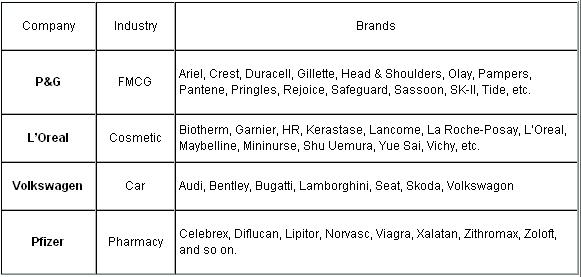

We all know that our lifestyle is filled with a large number of branded products, but you may not realize that many of the most commonly used product brands—Crest toothpaste, Pantene shampoo, Gillette shaving cream, Pringles potato chips and Duracell batteries—in fact belong to one company, in this case Proctor & Gamble (P&G). It has become very common for a company to have a portfolio of multiple brands, but what is the advantage of adopting a multi-brand strategy in today’s market?
Looking at several multi-brand companies, we can see that most exist in the B2C industries. For instance, this phenomenon can be observed in FMCG, cosmetics, automobile, as well as pharmaceutical fields. The following graph shows examples of companies in these industries, as well as their brands:


Unlocking consumer relevance and market influence, B2C industries strategically embrace multi-brand strategies to navigate the intricate landscape of diverse consumer preferences. In contrast to B2B sectors, where market segmentation is less pronounced, B2C companies recognize the need to tailor their approach to consumers with varied purchasing factors. Attempting to address this complexity with a single brand can challenge maintaining a strong brand identity. P&G’s multi-brand strategy exemplifies this approach, with distinct shampoo brands such as Head & Shoulders for dandruff control, Pantene for healthy hair, and Sassoon for a professional salon experience. This strategic diversification enables companies to occupy multiple market positions, maximizing relevance and resonance with consumers in an ever-evolving market.
From the brand management perspective, having multiple brands is a portfolio strategy which can maintain the continuity of profit-generating activities. The BCG Matrix model (pictured below) is based on the two indexes “current market share” and “market growth potential”. The brand portfolio of a company can be divided into four quadrants with each part representing a function. Using the example of L’Oreal, we will use this structure to illustrate the multi-brands practices.

Strategic Insights into Multi-Brand Strategy: Balancing Risks and Rewards
Delving into the realm of brand portfolio management reveals that opting for a vast brand portfolio is a strategic move best suited for larger corporations, steering clear of higher risks that may overwhelm smaller counterparts. This nuanced strategy demands careful consideration, especially when it comes to positioning the company’s brands within the same market. The absence of clear brand positioning can inadvertently spark unhealthy competition among the brand siblings, potentially harming the overall corporate entity. An additional challenge surfaces in the form of cost control, where the management of an expansive brand portfolio inevitably translates to higher operational costs. To navigate these intricacies, savvy companies often lean towards the strategy of brand extension, seamlessly extending a brand from one market to another. This prudent choice ensures strategic growth while mitigating the risks and cost implications associated with the management of a diverse multi-brand portfolio. Explore the strategic landscape of brand management as we delve into the considerations influencing the choice between multi-brand portfolios and brand extension.
A Labbrand Group Company © 2005-2024 Labbrand All rights reserved
沪ICP备17001253号-3To improve your experience, we use cookies to provide social media features, offer you content that targets your particular interests, and analyse the performance of our advertising campaigns. By clicking on “Accept” you consent to all cookies. You also have the option to click “Reject” to limit the use of certain types of cookies. Please be aware that rejecting cookies may affect your website browsing experience and limit the use of some personalised features.